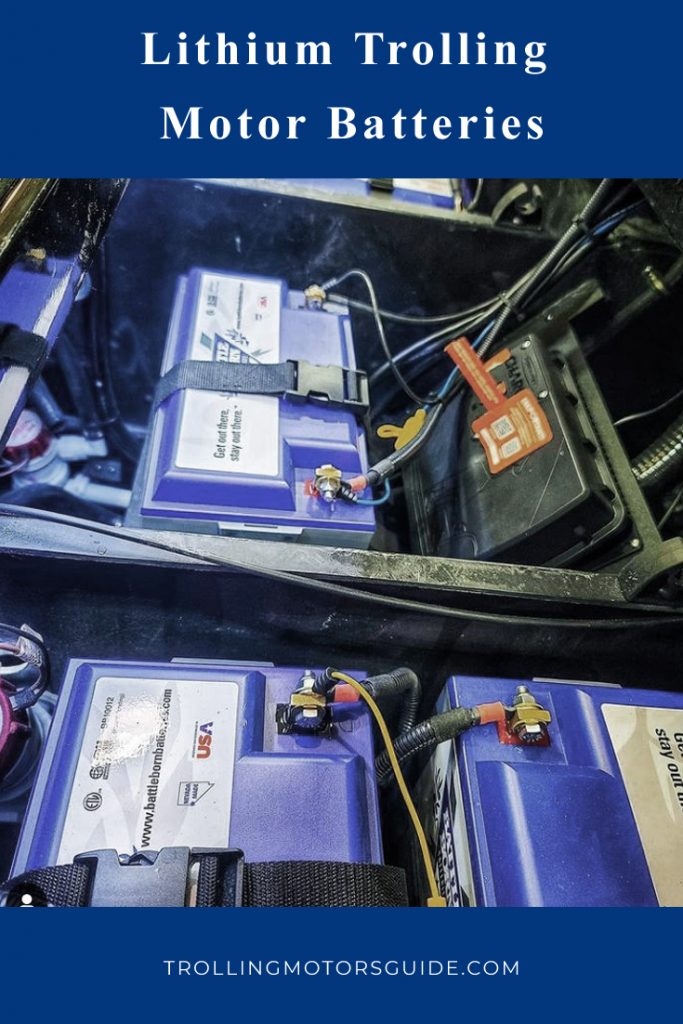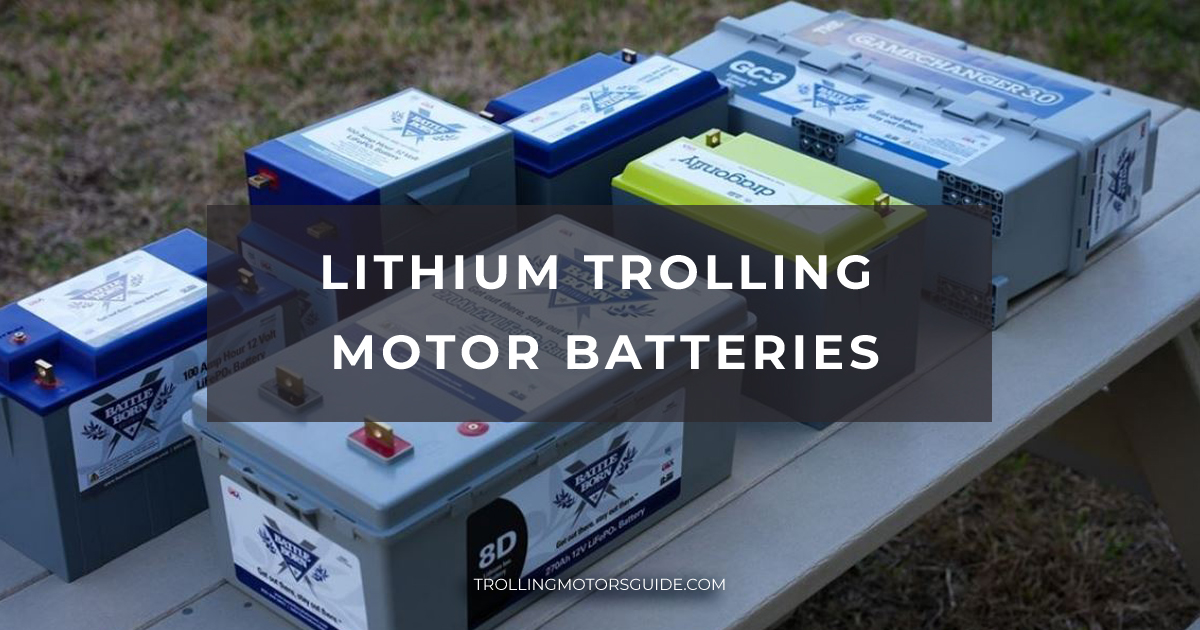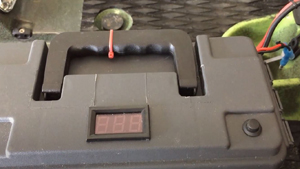
A proper choice of a battery for your trolling motor is essential.
A good battery can ensure long terms of fishing, minimal maintenance efforts, and safety.
An experienced fisher knows that there is nothing more frustrating than problems with a battery in the sea: they can discharge, leaving you helpless.
In some cases, water leaks into batteries, making them turn off or overheat. If you are sick and tired of constant searches and choices between longevity, safety, and reliability, the following post is for you.
Here, I’ve gathered everything that I know about lithium trolling motor batteries. You’ll find a description, how they work, and how the situation on the market looks now.
Lithium Trolling Motor Batteries: What Are They and How Do They Work?
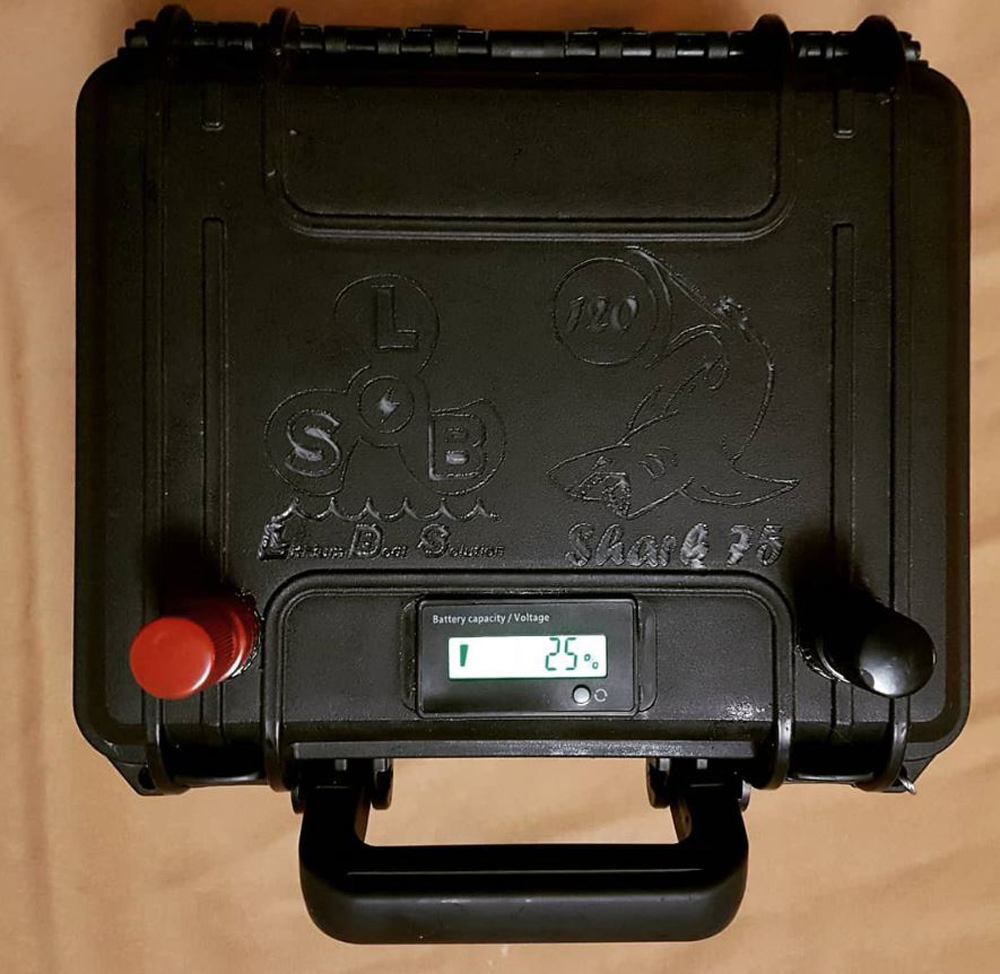
As you know, you need two batteries for your boat motor: a starting battery to start a motor and a deep cycle battery to ensure the longevity of motor workflow. Combined batteries exist, but they are usable only in small boats with low-power motors.
There are four main types of batteries. The main difference lay in chemicals and their physical state:
- Wet-cell batteries are filled with special liquid acid.
- Gel batteries have gelled contents instead of liquid.
- AGM (absorbed glass mat) batteries have got a dry fibreglass separator between the plates.
- Lithium batteries are powerful owing to pure metal plates inside. You’ve probably heard that lithium batteries are considered to be the best in the majority of spheres they are used. Mobile companies produce cell phone batteries made of lithium.
Lithium accumulators are considered to be the best.
How do they work?
The electricity inside a lithium battery is produced by the movement of ions (positively or negatively charged atoms and molecule particles).
This flow happens between a cathode (a part that gives away the electrons and accepts ions) and an anode (a part that accepts the electrons and gives away ions).
In a lithium battery, the cathode is formed from lithium metal oxide (cobalt in most cases). Pure lithium is very reactive.
Cobalt does not let lithium ions react with the environment.
An anode is formed by lithium-carbonate compounds (graphite) that can accept and build in the ions into their structure.
So, when a battery works, the ions move from the anode to the cathode, making the electrons move the other way. When the battery is charged, the process goes vice versa.
In your boat, a lithium battery works according to its purpose.
It is able to give short bursts of energy if it is a starting battery and discharge slowly, giving a stable power flow if it is a deep cycle battery.
Why Choose the Lithium Battery?
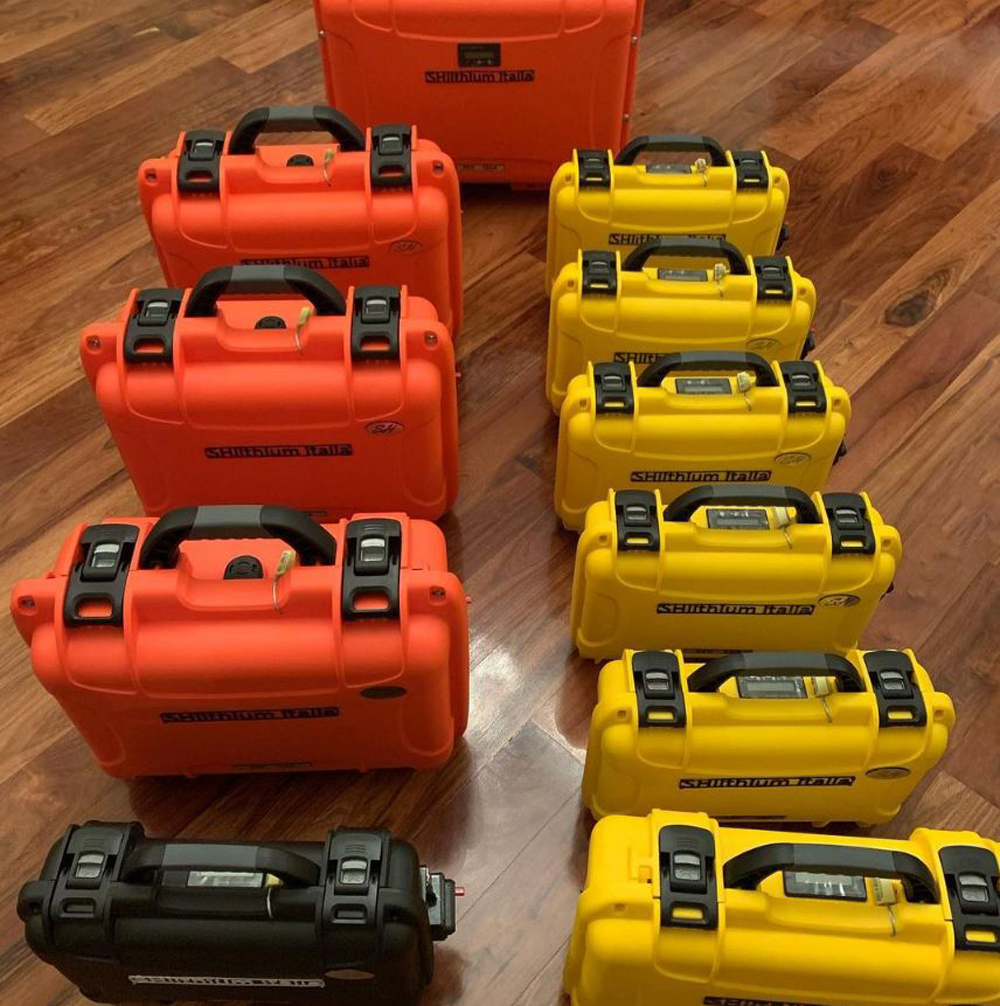
Choosing a proper battery for a boat is a cornerstone issue. Besides the reasons I’ve mentioned already, there are effectiveness, price, and cost-efficiency. What to choose? A low-budget variant is pleasant for your purse, but it can waste your nerves in the future.
On the other hand, you need to save money on high-quality equipment, which excludes fast decisions. In other words, the choice is up to you. Here, I will try to compare the batteries and highlight the main advantages of lithium batteries.
Wet-cell batteries deal easily with overcharges.
They are the exact low-budget variant available on the market in big numbers. Their features differ from producer to producer (even high-quality ones can give you a significant price), but their disadvantages are common.
Such batteries need a periodical inspection.
You need to check them for the electrolyte (acid) leaks that can do a lot of damage. You need to supply these batteries with distilled water as well. It is obvious that these batteries are very vulnerable to water and high-temperature differences.
They are likely to self-discharge in a state of rest. In addition, the liquid electrolyte does not stand long-term vibrations: it is likely to give away more electrolytes to be wasted for nothing.
Gel cells try to reduce the disadvantages of liquid electrolyte cells. They can stand extreme temperatures. Their leak-proof properties are much better.
You need fewer efforts to maintain them. As for the disadvantages, these batteries are not that good incapacity. They are sensitive to overcharging as well. Finally, their price is pretty high.
For a long time, AGM batteries have led the market. They do not need maintenance. AGM batteries are safe. They do not have liquid inside to leak. Compared to other battery types, these batteries showed the longest lifespan.
At the same time, they did not self-discharge too much. However, they are very sensitive to overcharging.
Finally, let’s talk about lithium batteries. They are the newest on the market, but now you can find a lot of variations on the market. Before we speak about the advantages of the battery, let’s consider some cons:
The price for a battery is high. To tell the truth, it is way more expensive than any other battery. If it is not, you are going to buy a lousy battery. In addition, they are very vulnerable to overheating.
You’ll need some protection, or at least covering a battery from direct sun rays. Though it does not need maintenance, in case of damage, you’ll need professional repair that will not be cheap.
These minuses cannot cover all the advantages that are beyond discussion:
- A lithium battery weighs less than any other battery. It means that the battery of volume similar to the other battery types will be from 170 to 225 lbs lighter.
It can be crucial for small fishing boats or boats with lots of equipment. It also means that you can get another spare battery on board without complications. - Lithium batteries are less likely to be disturbed by the environment. They always give away an equal and smooth electricity stream. Except overheating, lithium batteries are not vulnerable to vibration, cold temperatures, or water leaks.
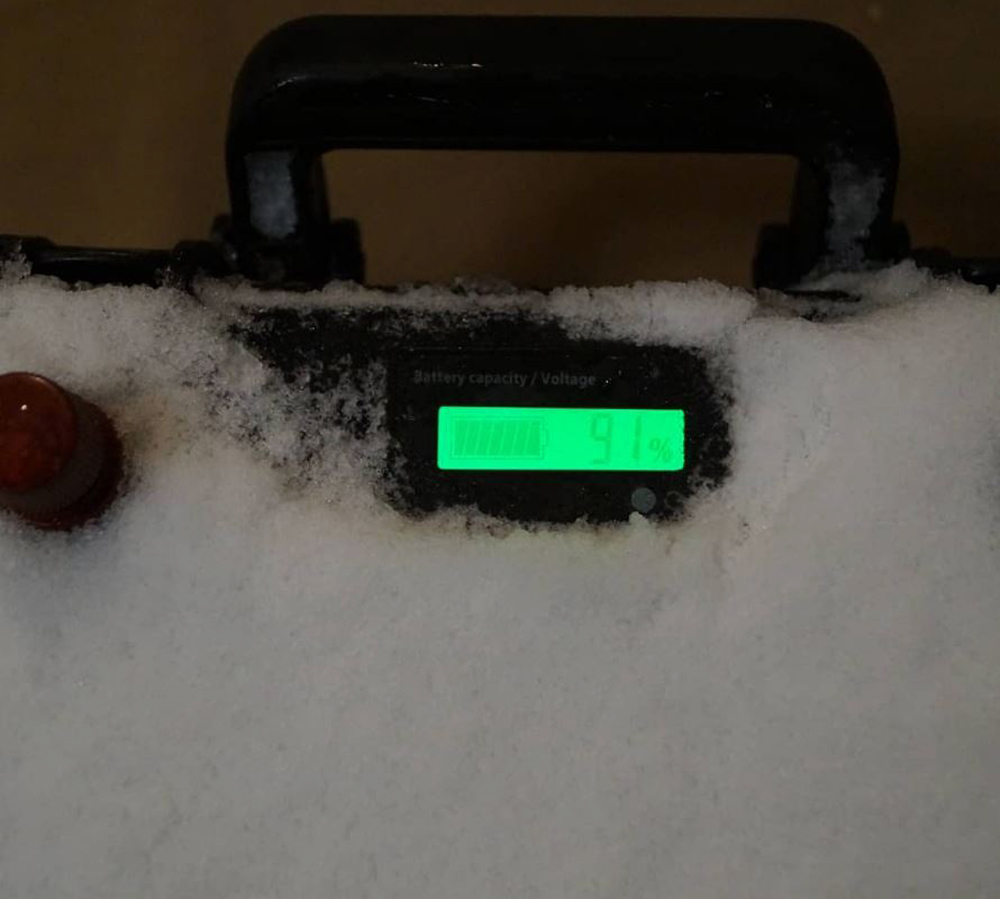
- The coolest advantage of a lithium battery is the number of times it can be discharged and charged again. Some producers claim that it can reach up to 700-800 times. Lithium batteries are irresistible to self-discharge.
Finally, lithium batteries hold more power and can work longer than their competitors.
As you can see, choosing a lithium battery is an investment to consider. You need to pay a lot, but you get reliable equipment that will work for you for many years.
If you are a trolling fishing enthusiast and you cannot live a season without it, such a battery is a must-buy.
Is Your Trolling Motor Compatible With a Lithium Battery?
This issue is more crucial than you think. With all the advantages, some lithium batteries are quite specific. Some of them cannot be members of the battery series for more powerful motors.
Some motors will not work at maximal speeds with lithium batteries, as they have been designed when such batteries did not exist yet.
The first thing you should know is that the majority of trolling motor producers suggest buying LiFePO4 batteries. It means that Ferrum (iron) stands as a supporting element in a battery.
Such batteries are more stable and give smoother electricity. What is for exact companies?
Before we start, note that if your motor is old (20+ years), probably, it has not been designed for lithium batteries.
They can overheat or damage a motor. In this case, we suggest consulting your motor producer before changing a battery.
- Minn Kota claims that its trolling motors can run on lithium batteries, though the majority of them were designed for liquid acid usage. They warn about possible damage in case of long usage of a motor at maximal speeds.
- Newport motors are more liberal to battery changes. They can stand maximal powers for a longer time, with less risk of damage. The only thing you should consider is the impossibility of installing a series of batteries.
If you have got a 24V or 36V motor, you cannot install a lithium battery as a substitution for a single battery in the chain.
Getting the whole chain battery slots substituted by lithium analogies will not do good: a group of batteries do not work as well as a single one does.
So, find a single battery for your Newport motor, and everything will be OK. - Haswing motors like lithium batteries. The newest items on the market go well with them, with no significant problems reported. Older models can be vulnerable to maximal powers, so be careful.
- Garmin motors are of the extra-sophisticated class. If you’ve got money to buy them, you would like to buy the best battery either. A lithium battery is your choice. And again, a single battery is your only way to success here.
- GoPlus motors are of a budget version. Though, their newest items are fully compatible with lithium batteries. The older models might have problems with maximal powers. A good alternator or an additional battery power control can solve the problem.
In general, if you are not sure about a lithium battery choice, we can recommend two more things to do besides consulting a motor producer.
You can consult a battery producer. They are interested in your success, so they should give you a tip. If it is not an option, you can run a test. For that, you need to know the AMP draw of a motor. As for the equipment, you’ll need:
Something to measure the temperature of a motor if it does not have an in-built thermometer.
Voltage and amperage meter. As a rule, special test claws have both functions.
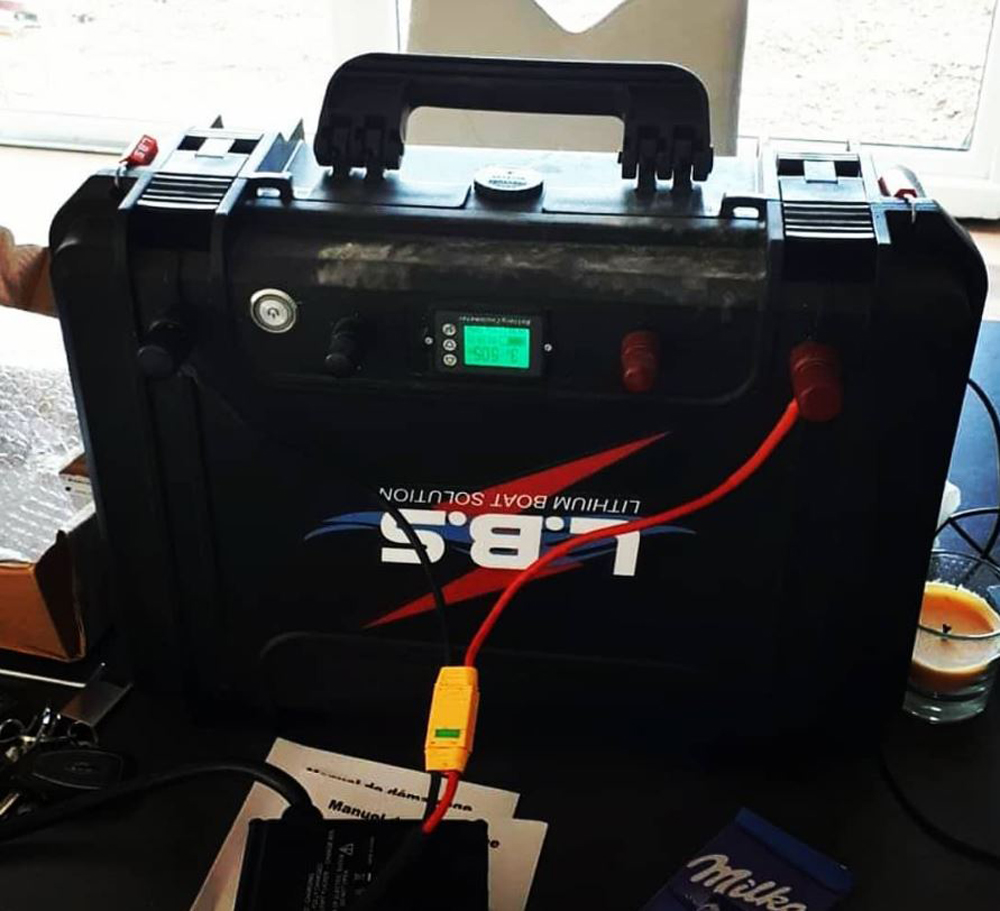
Apply the test instruments between a battery and motor, measure the voltage and power flowing from a battery, and perform a long-term test to guess if a motor overheats or not. Usually, there is no reason to worry.
5 Best Lithium Batteries
Here is my list of favourite batteries that are worth buying and considering.
1. AIMS LFP12V100AB

This battery has the following measures: 12.75 x 6.5 x 8.75 inches (~324 x 165 x 222 mm), 27.5 pounds.
It can give away 100 Amps continuously and 200 AMPs for 10 seconds.
Its only minus is a minimal minus temperature (-4 F) of discharge. Its advantage is increased durability: 4000 cycles of full discharge and 4800 with the 80% discharge.
Among pleasant features, there are a 10-years warranty and the ability to connect via Bluetooth, so you can monitor it with a phone.
2. Battle Born 100 Ah

This one is the best battery to be connected in packs and series. It is a lightweight and small battery (12.75 x 6.875 x 9 inches and only 29 pounds).
With a nominal 12V voltage, it gives away 12.8V of actual voltage. With at least 20% of capacity remaining, it can stand from 3000 to 5000 charging/discharging cycles.
It will be a perfect choice for motors that do not require more than 60 amps.
3. ExpertPower EP12100

It’s even a lighter battery (13 x 6.8 x 8.4/9.3 inches and 22.6 pounds. It gives away 12.6V and can do it up to 90% discharge.
The capacity of 100 Amps provides at least five hours of continuous work. However, this battery does not feel itself well in series.
It makes it a perfect choice for kayak trolling (minimal weight and dimensions can fit into the smallest boats), but if you need more power – choose something else.
4. Renogy RBT100LFP12S-G1

You can find this model in four variations – gel, AMG, lithium, and lithium smart. We’ll talk about the last one.
With the dimensions of 11.4 x 6.8 x 7.4 and a weight of 26 lbs, this battery is a solid 12V choice for you.
It shows good discharging vulnerability and can stand between 7000 (50%) to 3000 (80%) cycles. It is one of the best batteries of a quality/price ratio in this list.
5. Ampere Time 24V 100Ah

This 24V battery is bigger than others in the list (20.5 x 9.37 x 8.54 inches and 47.4 pounds) but smaller than other batteries being able to carry 2560 Wh.
Among its features, I can name a special battery management system that prevents it from self-discharging.
A single battery with a powerful current of 50A maximum can make a motor working for 2 hours in a row.
With an On and Off technique, the time can be prolonged. Trolling motor enthusiasts love this battery for its lightweight and pretty good power options.
Conclusions
The modern market is full of lithium battery options. Changing your trolling motor battery to lithium is a good idea.
You are less likely to see a battery discharged, and a perfect purchase will last long. Lithium batteries are expensive. It can be an obstacle.
The overall productivity makes lithium batteries better than other battery types, though.
